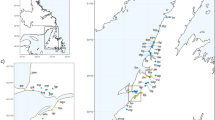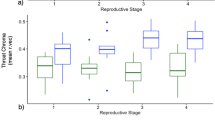Abstract
We describe the antipredator armour of a unique population of threespine stickleback (Gasterosteus aculeatus) from Narrows Pond in western Newfoundland and compare traits for this population to nearby populations from marine and freshwater systems. After standardizing for length, Narrows Pond stickleback are shallower bodied and have shorter dorsal spines than stickleback from the other populations. Also, though the number of armour plates for Narrows Pond stickleback is greater than for typical low-plate morphs, the size of the lateral plates for Narrows Pond stickleback is much smaller. Finally, most (nearly 75% of sampled individuals) Narrows Pond stickleback do not have a pelvic structure (bilateral pelvic plate, ascending process, and ventral spine), and the remaining individuals have greatly reduced pelvic girdle, whereas all individuals from the other populations possessed complete pelvic structures.





Similar content being viewed by others
Data availability
Data have been uploaded to Borealis and can be accessed at https://doi.org/10.5683/SP3/CT1SRW.
References
Arostegui MC, Quinn TP (2019) Reliance on lakes by salmon, trout and charr (Oncorhynchus, Salmo, and Salvelinus): an evaluation of spawning habitats, rearing strategies and trophic polymorphisms. Fish Fish 20:775–794. https://doi.org/10.1111/faf.12377
Barrett RDH (2010) Adaptive evolution of lateral plates in three-spined stickleback Gasterosteus aculeatus: a case study in functional analysis of natural variation. J Fish Biol 77(2):311–328. https://doi.org/10.1111/j.1095-8649.2010.02640.x
Bell MA (1987) Interacting evolutionary constraints in pelvic reduction of threespine sticklebacks, Gasterosteus aculeatus (Pisces, Gasterosteidae). Biol J Linn Soc 31:347–382. https://doi.org/10.1111/j.1095-8312.1987.tb01998.x
Bell MA, Orti G (1994) Pelvic reduction in threespine stickleback from cook inlet lakes, geographical distribution and intrapopulation variation. Copeia 2:314–325
Bell MA, Orti G, Walker JA, Koenings JP (1993) Evolution of pelvic reduction in threespine stickleback fish, a test of competing hypotheses. Evolution 47(3):906–914. https://doi.org/10.2307/2410193
Campbell RN (1985) Morphological variation in the 3-spined stickleback (Gasterosteus aculeatus) in Scotland. Behaviour 93:161–168. https://doi.org/10.1163/156853986×00838
Colosimo PF, Hosemann, KE, Balabhadra, S. Villarreal, G, Dickson, M, Grimwood, J, Schmutz, J, Myers, RM, Schluter, D, Kingsley, DM (2005) Widespread parallel evolution in sticklebacks by repeated fixation of ectodysplasin alleles. Science 307 (5717): 1928-1933. https://doi.org/10.1126/science.110723.
Coyle SM, Huntingford FA, Peichel CL (2007) Parallel evolution of Pitx1 underlies pelvic reduction in Scottish threespine stickleback (Gasterosteus aculeatus). J Hered 98(6):581–586. https://doi.org/10.1093/jhered/esm066E
DeGrace, JR (1974) Limestone resources of Newfoundland and Labrador, Report 74–2. Newfoundland Department of Mines and Energy, Mineral Development Division.
Edge TA, Coad BW (1983) Reduction of the pelvic skeleton in the threespine stickleback, Gasterosteus aculeatus, in 2 lakes of Québec. Can Field Nat 97(3):334–336
Fang B, Kemppainen P, Momigliano P, Feng X, Merilä J (2020) On the causes of geographically heterogeneous parallel evolution in sticklebacks. Nat Ecol Evol 4:1105–1115. https://doi.org/10.1038/s41559-020-1222-6
Foster SA, Scott RJ, Cresko WA (1998) Nested biological variation and speciation. Philos T Roy Soc B 353(1366):207–218. https://doi.org/10.1098/rstb.1998.0203
Giles N (1983) The possible role of environmental calcium levels during the evolution of phenotypic diversity in Outer Hebridean populations of the 3-spined stickleback. Gasterosteus Aculeatus J Zool 199(4):535–544. https://doi.org/10.1111/j.1469-7998.1983.tb05104.x
Government of Newfoundland and Labrador (1992) Water Resources Atlas of Newfoundland. Water Resources Division, Department of Lands, St. John’s, NL, Canada.
Hagen DW, Moodie GEE (1982) Polymorphism for plate morphs in Gasterosteus aculeatus on the east coast of Canada and an hypothesis for their global distribution. Can J Zool 60:1032–1042. https://doi.org/10.1139/z82-144
Hindar A, Nilsen P, Skiple A, Hogberget R (1995) Counteractions against acidification in forests ecosystems, effects on stream water quality after dolomite application to forest soil in Gjerstad. Norway Water Air Soil Poll 85(2):1027–1032. https://doi.org/10.1007/bf00476965
Huntingford F, Giles N (1987) Individual variation in anti-predator responses in the three-spined stickleback (Gasterosteus aculeatus L.). Ethology 74:205–210
Klepaker T, Østbye K (2008) Pelvic anti-predator armour reduction in Norwegian populations of the threespine stickleback: a rare phenomenon with adaptive implications? J Zool 276(1):81–88. https://doi.org/10.1111/j.1469-7998.2008.00471.x
Klepaker T, Østbye K, Bernatchez L, Vøllestad LA (2012) Spatio-temporal patterns in pelvic reduction in threespine stickleback (Gasterosteus aculeatus L.) in Lake Storvatnet. Evol Ecol Res 14(2):169–191
Klepaker T, Østbye K, Bell MA (2013) Regressive evolution of the pelvic complex in stickleback fishes: a study of convergent evolution. Evol Ecol Res 15:413–435
Klepaker T, Østbye K, Spence R, Warren M, Przybylski M, Smith C (2016) Selective agents in the adaptive radiation of Hebridean sticklebacks. Evol Ecol Res 17:243–262
LaCasse J, Aubin-Horth N (2012) A test of the coupling of predator defense morphology and behavior variation in two threespine stickleback populations. Curr Zool 58(1):53–65. https://doi.org/10.1093/czoolo/58.1.53
Lescak EA, von Hippel FA, Lohman BK, Sherbick ML (2012) Predation of threespine stickleback by dragonfly naiads. Ecol Freshw Fish 21(4):581–587. https://doi.org/10.1111/j.1600-0633.2012.00579.x
Lleornart J, Salat J, Torres GJ (2000) Removing allometric effects of body size in morphological analysis. J Theor Biol 205:85–93
Losos JB (2010) Adaptive radiation, ecological opportunity, and evolutionary determinism. Am Nat 175(6):623–639. https://doi.org/10.1086/652433
MacColl ADC, Aucott B (2014) Inappropriate analysis does not reveal the ecological causes of evolution of stickleback armour: a critique of Spence et al. 2013. Ecol Evol 4: 9503–3513.
Mesler A, Wund MA, Baker JA, Foster SA (2007) The effects of relaxed and reversed selection by predators on the antipredator behavior of the threespine stickleback, Gasterosteus aculeatus. Ethology 113:953–963. https://doi.org/10.1111/j.1439-0310.2007.01416x
Ministére du Développement durable, Environnement et Parcs (2008) Parc national du Lac-Témiscouata: États des connaissance. ISBN : 978–2–550–52191–4
Quinn GP, Keough MJ (2002) Experimental design and data analysis for biologists. Cambridge University Press, Cambridge, UK
Reimchen TE (1983) Structural relationships between spines and lateral plates in threespine stickleback (Gasterosteus aculeatus). Evolution 37(5):931–946. https://doi.org/10.2307/2408408
Reimchen TE (1984) Status of unarmoured and spine-deficient populations (Charlotte unarmoured stickleback) of threespine stickleback, Gasterosteus sp, on the Queen Charolotte Islands. British Columbia Can Field Nat 98(1):120–126
Reimchen TE (1991) Trout foraging failures and the evolution of body size in stickleback. Copeia 1991:1098–1104
Reimchen TE (1992) Injuries on stickleback from attacks by a toothed predator (Ochorhynchus) and implications for the evolution of lateral plates. Evolution 46:1230–1236
Reimchen TE, Bergstrom C, Nosil P (2013) Natural selection and the adaptive radiation of Haida Gwaii stickleback. Evol Ecol Res 15(3):241–269
Roberts Kingman GA, Le D, Jones FC, Desmet D, Bell MA, Kingsley DM (2021) Longer or shorter spines: reciprocal trait evolution in stickleback via triallelic regulatory changes in Stanniocalcin2a. P Natl Acad Sci-Biol 118: e2100694118. https://doi.org/10.1073/pnas.2100694118.
Robinson BW, Parsons KJ (2002) Changing times, spaces, and faces: tests and implications of adaptive morphological plasticity in the fishes of northern postglacial lakes. Can J Fish Aquat Sci 59(11):1819–1833. https://doi.org/10.1139/f02-144
Robinson BW, Wilson DS (1994) Character release and displacement in fishes - a neglected literature. Am Nat 144(4):596–627. https://doi.org/10.1086/285696
R Core Team (2022) R: A language environment for statistical computing. R Foundation for Statistical Computing, Vienna, Austria, URL: https://www.R-project.org/.
RStudio Team (2020) RStudio: integrated development for R. RStudio, PBS, Boston, MA. URL: http://www.rsctudio.com.
Schneider C, Rasband W, Eliceiri K (2012) NIH Image to Image J: 25 years of image analysis. Nat Methods 9:671–675. https://doi.org/10.1038/nmeth.2089
Scott RJ, Haines GE, Biedak N, Baker JA (2022) Variation in morphology among populations of threespine stickleback (Gasterosteus aculeatus) from western Newfoundland, Canada. Submitted to Environmental Biology of Fishes.
Smith C, Spence R, Barber I, Przybylski M, Wooton R (2014) The role of calcium and predation on the plate morph evolution in the three-spined stickleback (Gasterosteus aculeatus). Ecol Evol 4:3550–3554
Song JK, Parenti LR (1995) Clearing and staining whole fish specimens for simultaneous demonstration of bone, cartilage, and nerves. Copeia 1:114–118
Spence R, Wooton J, Barber I, Przybylski M, Smith C (2013) Ecological causes of morphological evolution in the three-spined stickleback. Ecol Evol 3:1717–1726
Stuart YE, Veen T, Weber JN, Hanson D, Ravinet M, Lohman BK, Thompson CJ, Tasneem T, Doggett A, Izen R, Ahmed N, Barrett RDH, Hendry AP, Peichel CL, Bolnick DI (2017) Contrasting effects of environment and genetics generate a continuum of parallel evolution. Nature Ecol Evol 1:0158. https://doi.org/10.1038/s41559-017-0158
Xie TK, Wang G, Thompson AC, Wucherpfennig JI, Reimchen TE, MacColl ADC, Schluter D, Bell MA, Vasquez KM, Kingsley DM (2019) DNA fragility in the parallel evolution of pelvic reduction in stickleback fish. Science 363(6422):81–84. https://doi.org/10.1126/science.aan1425
Acknowledgements
J. Moriera, M. Graham, D. Budgill, and W. Rauch-Davis assisted with collections, and W. Rauch Davis also assisted with image capture and digitization. We thank two anonymous reviewers who improved the manuscript.
Funding
This research was supported by the Grenfell Campus Research Fund and NSERC USRA (to C.A. Trask), approved by the Memorial University Animal Care committee, and conducted under collection permits issued by Parks Canada and Department of Fisheries and Oceans Canada.
Author information
Authors and Affiliations
Corresponding author
Ethics declarations
Ethical approval
All field collections were carried out under Memorial University Animal Care approval (file numbers 20090160 and 2018015) and under Scientific Collection permits issued by Parks Canada and department of Fisheries and Oceans Canada.
Conflict of interest
The authors declare no competing interests.
Additional information
Publisher's note
Springer Nature remains neutral with regard to jurisdictional claims in published maps and institutional affiliations.
Rights and permissions
Springer Nature or its licensor (e.g. a society or other partner) holds exclusive rights to this article under a publishing agreement with the author(s) or other rightsholder(s); author self-archiving of the accepted manuscript version of this article is solely governed by the terms of such publishing agreement and applicable law.
About this article
Cite this article
Scott, R.J., Haines, G.E. & Trask, C.A. Armour reduction and pelvic girdle loss in a population of threespine stickleback (Gasterosteus aculeatus) from western Newfoundland, Canada. Environ Biol Fish 106, 685–695 (2023). https://doi.org/10.1007/s10641-023-01407-z
Received:
Accepted:
Published:
Issue Date:
DOI: https://doi.org/10.1007/s10641-023-01407-z




